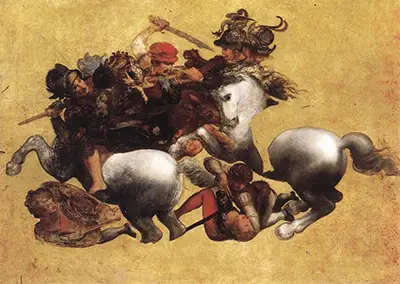The Battle of Anghiari saw a Milanese force go up against troops from the Italian League. The Italian League’s army involved forces from the Republic of Florence with support from Papal troops.
There was also a group of Knights from the Republic of Venice as well as men from Anghiari. By the end of the day, the outcome of the battle was a victory for the Florentine army. It meant that Florence’s control of central Italy was secure.
For the people of Florence, the Battle of Anghiari was an important victory for them. During the early 1500’s, to mark their victory, they hired Leonardo Da Vinci to paint a mural of The Battle of Anghiari. The mural was for the Salone dei Cinquecento (Hall of the Five Hundred) of the Palazzo Vecchio in Florence.
The painting of the Battle of Anghiari was to be one of Da Vinci’s most ambitious works. It was to be a large scale work measuring a massive 54ft by 21ft in size. The goal was to have three scenes that showed the beginning, middle and the end of the battle.
Thanks to preparatory studies by Leonardo Da Vinci which still exist, much is known about the painting. For example, he produced two studies of men shouting as part of his research for the painting. Of the three sections, the central scene of the battle is the one best known today.
The scene in the centrepiece of the picture is of four riders of colliding horses and cavalry. The picture shows the riders battling for control of the standard at the Battle of Anghiari. What can be seen is the Florentine commander, Pier Giampaolo Orsini about to wrench the standard away from the Milanese leader Niccolo Piccinino.
The picture portrays a sense of power and emotion along with a sense of fury and violence. This is not just in the faces of the soldiers but also in the horses. Writers at the time commented on Da Vinci’s design. They mention his skill in the design of the soldiers’ uniforms as well as the bold features of the horses.
That we know so much about the centrepiece is probably down to the fact that there are copies of it. One of those copies was by Peter Paul Rubens in 1603. Although it is not an exact copy, the drawing of the central section shows how it might have looked. Rubens' drawing now hangs in the Louvre, Paris.
Da Vinci did not complete the painting of the Battle of Anghiari. He stopped work on the painting in 1505 when he left Florence for Milan. Although abandoned, the parts that he had completed remained in the Hall for some years afterwards.
In working on the artwork, Da Vinci decided to use a technique known as encaustic which translates as ‘fixing by heat’. The method involves hot wax painting.
It requires heating beeswax and adding coloured pigments to it. Because the technique he was planning to use was new, Da Vinci carried out a trial run. He did this by applying it to a board that dried well in a warm environment.
In his painting of the battle, Leonardo Da Vinci wanted to use oil colours on the wall with its thick wax undercoat. Sadly, work on the painting was not without problems.
He set up large charcoal braziers close to the picture. Probably because of the painting’s large size, Da Vinci was unable to get the heat from the braziers to spread evenly over it. The result was damage to the painting. While he was able to save the lower part of the work, the colours at the top ended up mixing together.
As the painting of the battle was so large, Da Vinci came up with a unique design for the scaffolding he needed. The design meant that he could raise or fold it in a way that changed its height or position.
In being able to do this, it meant that it was easier for him to complete the upper section of his artwork. Despite all of the problems, Da Vinci had, the work was visible for several years.
As such, painters like Rubens were able to copy it, and today we have evidence of the great work. Sometime between 1555 and 1572 the painting was lost when Giorgio Vasari carried out work on the ‘Hall of the Five Hundred’. Many think that the picture remains in the hall and that Vasari simply covered over it.
Da Vinci’s painting celebrating the Battle of Anghiari is a lost work of art. Some believe it still exists under one of the later frescoes in the Hall of the Five Hundred in the Palazzo Vecchio.
Despite surveys, there has been no evidence found to prove once and for all that the painting does exist.


